The appearance of Spring vegetables makes me geek out, particularly when I spot the season’s first fava beans and bunched radishes. Seriously, last April one of the farmers at the greenmarket told me he’d never seen someone get so excited about radish greens. What can I say? Good produce makes me happy. Anyway, when I got my hands on beautiful favas and radishes last week, I knew I needed to feature them in a post immediately. This salad is crisp, cool, creamy, refreshing, and perfect as a substantial appetizer or a light meal on its own. I can’t think of a better way to celebrate the arrival of Spring.
Fresh fava beans (aka broad beans) are a staple of Mediterranean and Middle Eastern cuisine, but until recently they weren’t all that common here in the West. I’d still categorize them as something of a niche ingredient, but when they’re in season they’re easy to find at farmers’ and specialty markets and some well-stocked supermarkets. With a subtle flavor that’s equal parts grassy and nutty, and a beautiful emerald green color, fresh fava beans are worth seeking out. I confess they’re a bit labor-intensive – you’ll need to remove them from the pods and cook them, then peel off the tough outer skin – but all of that is easy and doesn’t require much time. When shopping for fava beans, select pods that feel smooth and evenly firm from end to end (if you feel empty spaces/pockets along the length of a pod, toss it back in the bin and keep looking). The yield on these is pretty low in relation to weight since the pods are heavy, so bear in mind that one pound of pods will yield ½ to ¾ cup of shelled beans depending on the size of the actual beans.
After you’ve removed all the fava beans from the pods, you’re going to simmer them in salted water for about a minute, then transfer to a ice bath to cool for a few minutes. Once the beans are cool you need to peel them, and it’s surprisingly easy and quick work. Pinch the very end of the skin between your thumb and index finger and squeeze gently. The skin will start to split, and the bean will slip right out. If some of the beans are stubborn, you can tear off a tiny piece of skin to get things moving.
Pinch, squeeze, and slide – just like that! Discard the skins when you’re done, and ponder that amazing, vibrant green color for a moment.
I like to pair favas with their more widely recognized seasonal cousins, sugar snap peas. Crisp and sweet with that delightful pop when you bite into a pea, they’re the perfect complement to fava beans and are really refreshing in this salad. Snap peas are pretty common and you’ve likely had them, so I’ll spare you a detailed primer. I do urge you to seek them out at farmers’ markets while they’re in season and available straight from the source, but if you only have access to supermarket snap peas, they’ll still be good.
So, let’s talk radishes now. Unless you have access to a good greenmarket, you’ve probably only had the standard globe radishes with red, white or purple skin, and white flesh inside, and perhaps white daikon radish if you enjoy Chinese, Japanese or Vietnamese cuisine. Either way, they have thin skin and crisp, slightly peppery flesh, so a radish is a radish is a radish, right?
Nope.
There are scores of radish varieties, and they differ in color, shape, size, and flavor. See the light purple one in the back of the photo? That’s a purple daikon, and the flesh inside is mottled purple and white. The flavor is pretty mild. The oblong green and white one on the right? That’s a “green meat” radish, named as such because it’s green inside; also relatively mild-tasting. If you follow me on Instagram you probably already know this, but there’s another special radish variety of which I’m a huge fan – the watermelon radish. The unremarkable-looking whitish one on the left? that’s a watermelon radish. There’s a reason for the name…
Can you believe that’s a radish? These beauties are tougher-skinned than globe radishes, with slightly softer, mild-tasting flesh. Watermelon radishes can grow to be absolutely enormous – earlier this year I purchased one to use for a dinner party that was literally the size of a grapefruit and weighed 3 pounds. It made sense on that occasion because I was dicing it into cubes for an appetizer to feed a lot of people, but I can’t imagine having many other reasons to use such a giant radish.
The other variety I like to use in this salad is the French breakfast radish, but unfortunately the farm stand was out of them by the time I got there so I don’t have a photo and didn’t use any in this batch. With gorgeous fuschia and white skin and really crisp white flesh, they’re delicate and wonderful and worth trying.
If I can offer you one final and important tidbit about radishes, it’s this: whenever possible, buy them with the greens still attached, and use the greens! They have a slightly pungent, peppery flavor similar to the actual radish, and they’re super nutritious. Turn them into pesto, sauté them with garlic and a little acid, cook and blend them into a green soup…there are so may ways to enjoy them beyond slicing them up for this salad. Radish greens are highly perishable and will actually spoil faster if they remain attached to the radishes. Be sure to cut them off as soon as you get them home, give them a thorough soak in water to remove all the grit, and dry them well before refrigerating. I recommend using them within 2-3 days. And that, my friends, is probably more than you thought you ever needed to know about radishes, so let’s move on.
Okay, maybe one last look at the assorted slices I added to my salad, just because they’re so pretty.
When slicing the greens, stack them on the cutting board, fold or roll the stack lengthwise to decrease your cutting surface area, and slice into thin ribbons (⅛ to ¼ inch is fine). And no, those aren’t radish greens in the photo. I stupidly used mine up, so I substituted some dandelion greens that I had on hand.
Fennel is another major vegetable component of this salad, and like the others, it’s at peak season right now. I adore fennel, raw or cooked, in all its anise glory. It’s also another vegetable that has multiple usable parts, so don’t go throwing away the stalks or the green fronds that are attached to them. Pull off the fronds, chop them up, and use them as you would any green herb. Then roast the stalks to deepen the flavor, and add them to soup stock. No waste. Boom.
Notice how I sliced the fennel here? I cut off the piece of core that was jutting from the bottom, stood the bulb upright on the board, and cut it in half through the top, lengthwise. Then I started cutting paper-thin slices from the rounded outer surface of one half until it was flat. Now I can do the same thing on the left and right until all surfaces are flat, and continue slicing all the way to the center. Once I hit the really tough core, I’m done. (Toss the core – that’s the one bit of waste here.) You want the fennel slices super thin, so if you have a mandoline go ahead and use it.
Lastly on the vegetables, I’ve added a couple of thinly sliced Persian cucumbers. I love their diminutive size and big crunch, and they’re easier on the digestive system than standard cukes because they’re nearly seedless. If you can’t find good Persian cucumbers, substitute half of a large English seedless (aka hothouse) cucumber. There’s some caper and shallot in the salad too, but you don’t really need visuals or instructions for that – details are in the recipe.
All that’s left now is the dressing, and it’s a keeper! Light, creamy, tangy, and loaded with fresh mint, I could probably drink this stuff straight. You have a few options for the base – if you eat dairy, I recommend kefir for its uniquely effervescent tang and all those beneficial probiotics. Not into kefir? Use buttermilk, or yogurt soured with some apple cider vinegar or lemon. If you’re dairy-free you can substitute coconut kefir, or spike some coconut-milk yogurt with lemon juice or vinegar. The keys here are creaminess and tang, however you choose to achieve that.
Chop up the mint pretty finely. It doesn’t need to be minced, but you want small flecks of it evenly distributed throughout the dressing.
Add all the ingredients to a bowl, and whisk to combine throughly.
Easy peasy. Taste it, and if you feel like it needs a little more salt or pepper (or both), season it to your liking. Then pour it over the vegetables, toss everything together, and serve! If you like more sweetness in your salad, fold in some slices or supremes of orange – they’ll do the trick without throwing off the balance of flavors.
Enjoy!
- For Salad
- 2 oz (1 large) shallot (or use half of a small red onion)
- 8 oz sugar snap peas, tough ends trimmed, strings removed
- 1 lb fava bean pods, beans removed, pods discarded (yield 6 oz or 1 ½ cups beans)
- 2 packed cups peppery or bitter greens* such as watercress, dandelion, arugula or endive
- 8 oz assorted radishes
- 2 Persian cucumbers (4-5 oz total), washed and dried but not peeled
- 1 small or medium fennel bulb (6-8 oz), scrubbed and dried
- 2 large stalks celery (4 oz total), washed and dried
- 12 grams (4 tsp) drained capers
- For Dressing
- ½ cup lightly packed fresh mint leaves, washed and dried
- 180ml (¾ cup) kefir or buttermilk
- 30ml (2 Tbsp) champagne vinegar
- 30ml (2 Tbsp) extra virgin olive oil
- 1 small garlic clove, grated
- ¼ tsp kosher salt
- Several grinds black pepper
- Optional
- Extra mint leaves for garnish, if desired
- One orange, peeled and cut into supremes or slices**
- Peel the shallot, slice in half lengthwise, and cut out the core at the top, Cut into very thin slices, add to a small bowl, cover with cold water, and set aside to soak. (Do the same if substituting red onion.)
- Bring a medium saucepan of salted water to a boil. While the water is heating, prepare an ice bath and set aside.
- Drop the snap peas into the boiling water and blanch for 60-90 seconds until bright green and barely tender. Use a spider or slotted spoon to transfer them to the ice bath.
- Drop the fava beans into the same pot of water, and simmer until the beans float to the surface - this will only take about a minute. Transfer the beans to the ice bath with the snap peas, and discard the cooking water. Let the snap peas and fava beans cool for 2-3 minutes, then set aside to drain in a colander.
- Wash and dry the greens, and slice into chiffonade (thin ribbons). Transfer to a large bowl and set aside. If you purchased bunched radishes with their greens attached, you can substitute them for all or part of the greens. Be sure to wash and dry them well first.
- Scrub the radishes with a vegetable brush, and dry them. Trim off and discard the wispy roots. Beginning at the trimmed end, use a mandoline or very sharp knife to slice the radishes as thinly as possible. Discard the piece at the very top where the greens were attached, and add the sliced radishes to the bowl with the greens.
- Trim off and discard the ends of the cucumbers, and slice the cucumbers into very thin rounds. Add them to the bowl with the radishes.
- Pull off and reserve the fennel fronds, and cut off and discard the stalks at the top and the tough core at the bottom. Stand the bulb upright and slice in half, then cut each half into very thin slices. Add the fennel slices to the bowl.
- Wash and dry the celery, and trim off the end at about a 45-degree angle. Follow that angle to thinly slice the celery on the diagonal. Add the sliced celery to the bowl.
- Drain the shallots and add to the sliced vegetables. Peel off and discard the leathery white skin from the fava beans, and cut the snap peas on the diagonal into 1-inch pieces. Add the snap peas and favas to the vegetables. Chop 1-2 tablespoons of the reserved fennel fronds and add to the vegetables. Add the drained capers as well.
- Chop the mint finely and add to a small bowl. Add the kefir or buttermilk, vinegar, olive oil, garlic, salt, and pepper. Whisk to blend, taste and adjust with more salt or pepper if desired, and pour about ¾ of the dressing over the vegetables. Toss gently to distribute everything evenly, and fold in optional orange if using. Add remaining dressing if desired. Garnish with torn mint leaves.
**If you like a little more sweetness in your salad, an orange is the perfect option for this recipe. Be sure to trim away all the peel and bitter pith before cutting into supremes or slices. See here for photos and instructions.
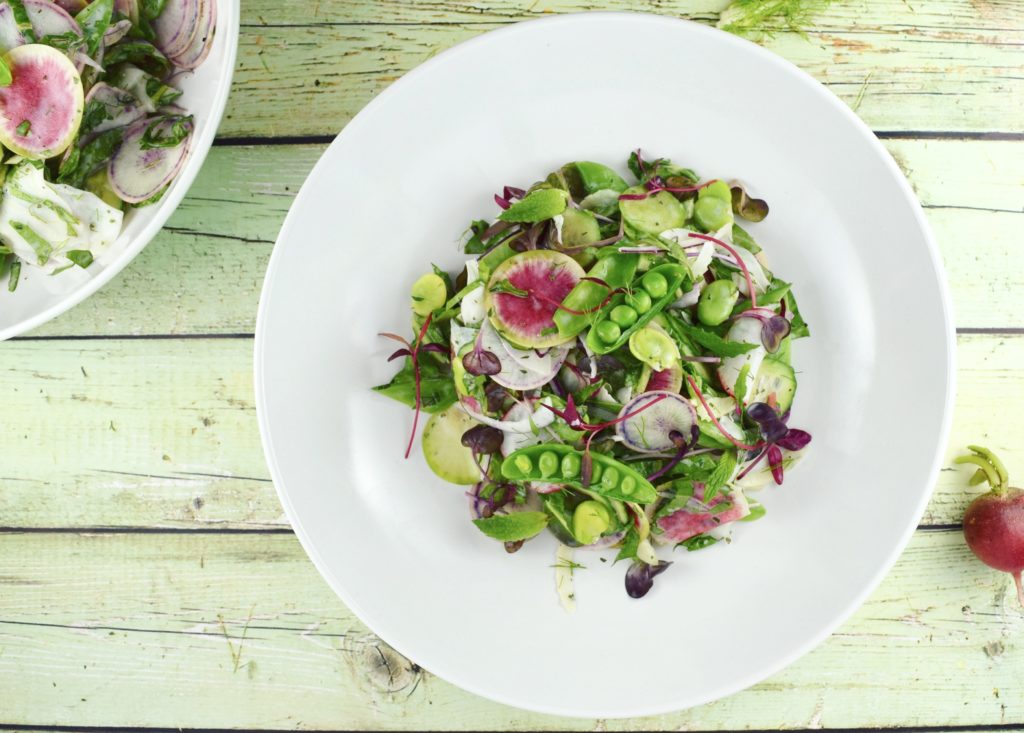
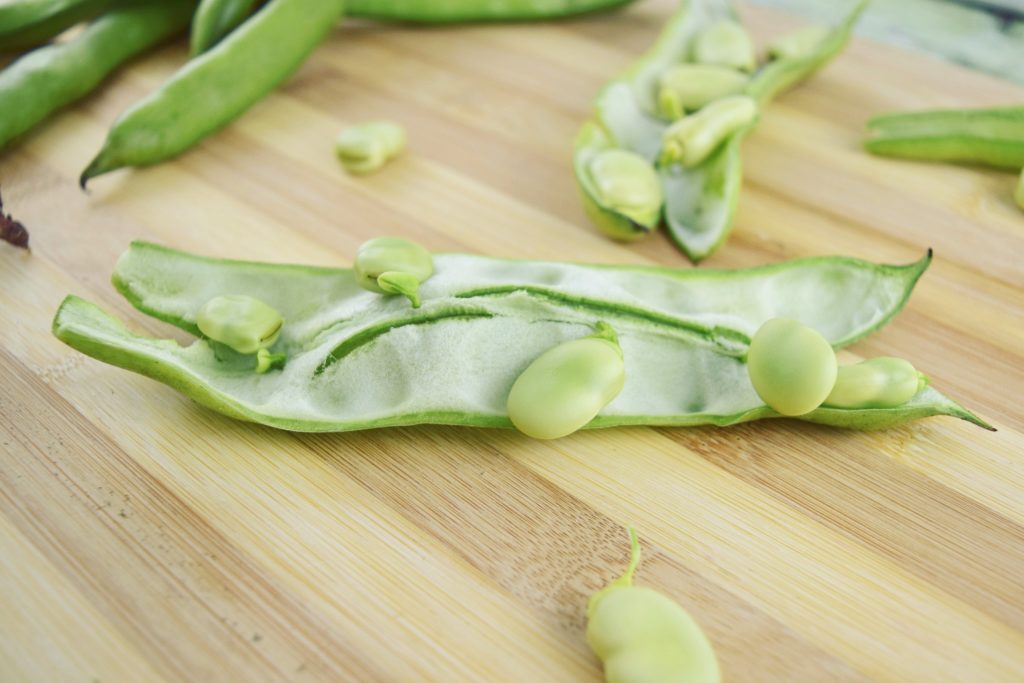
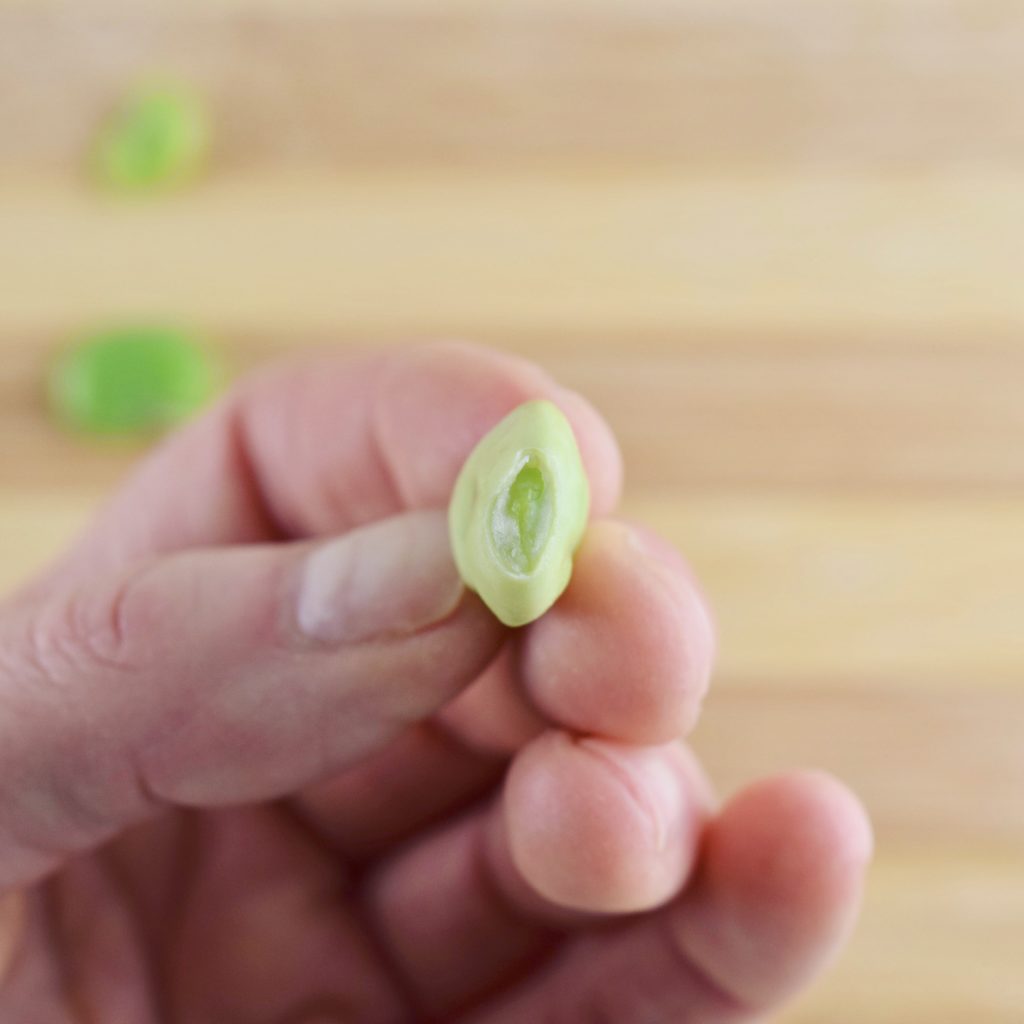
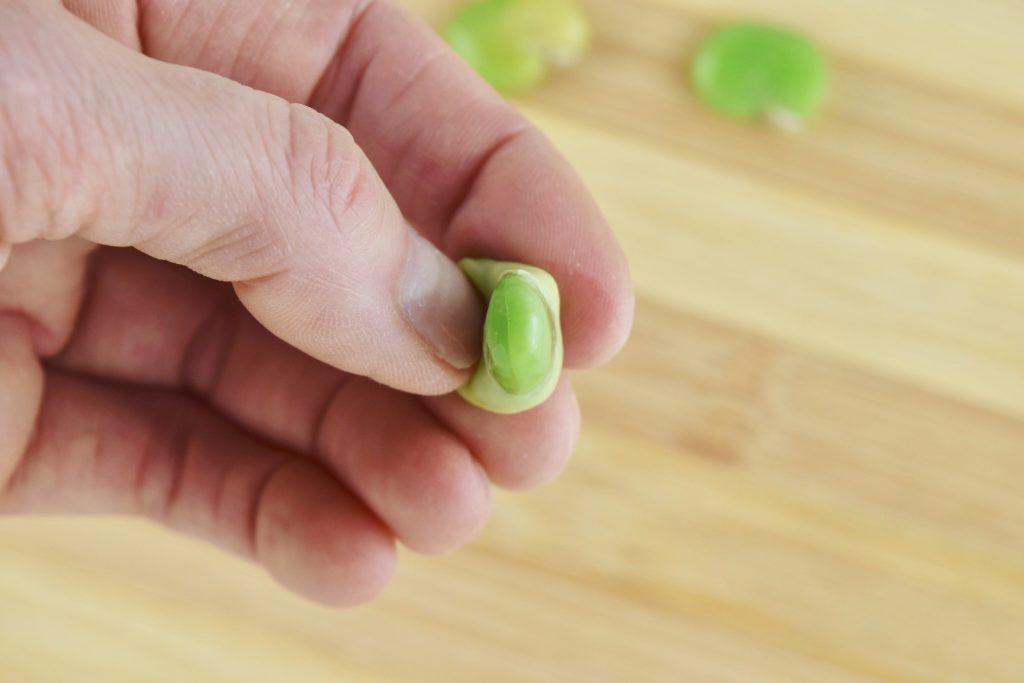
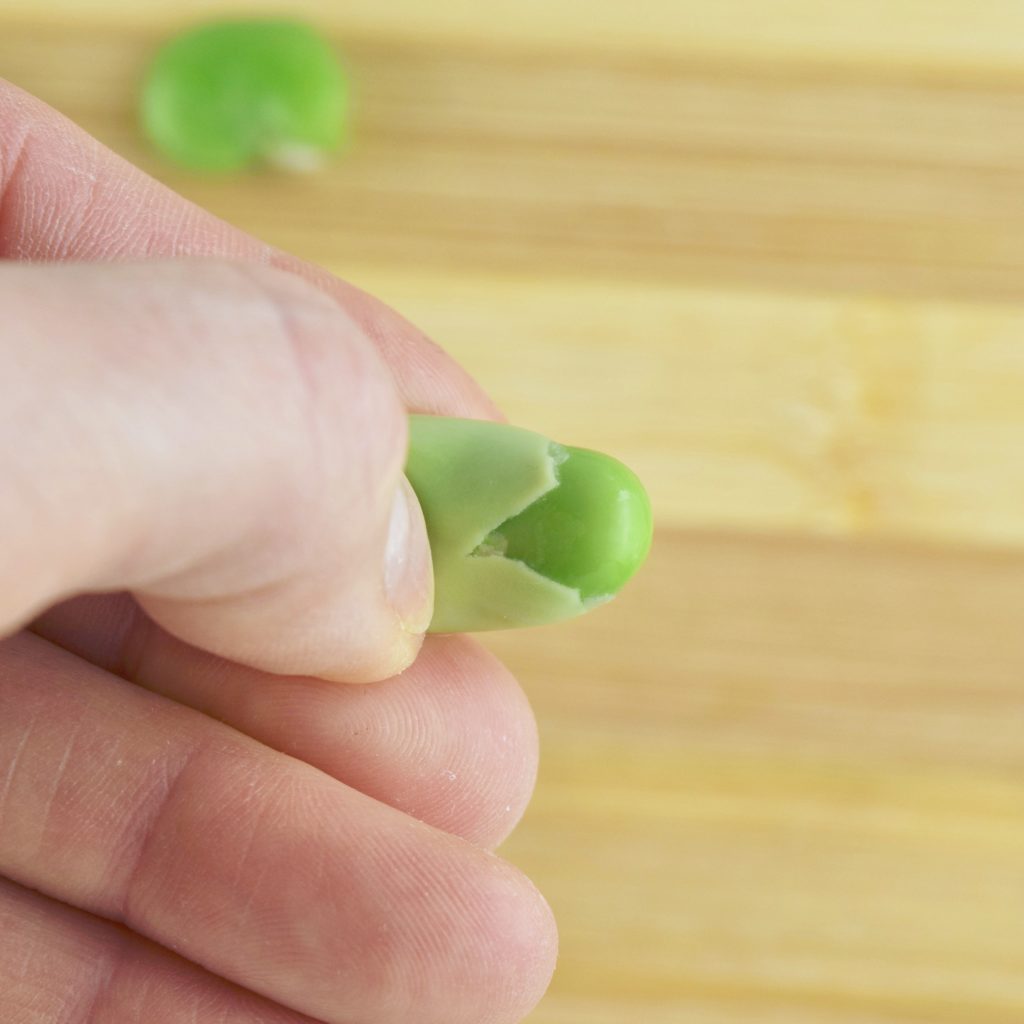
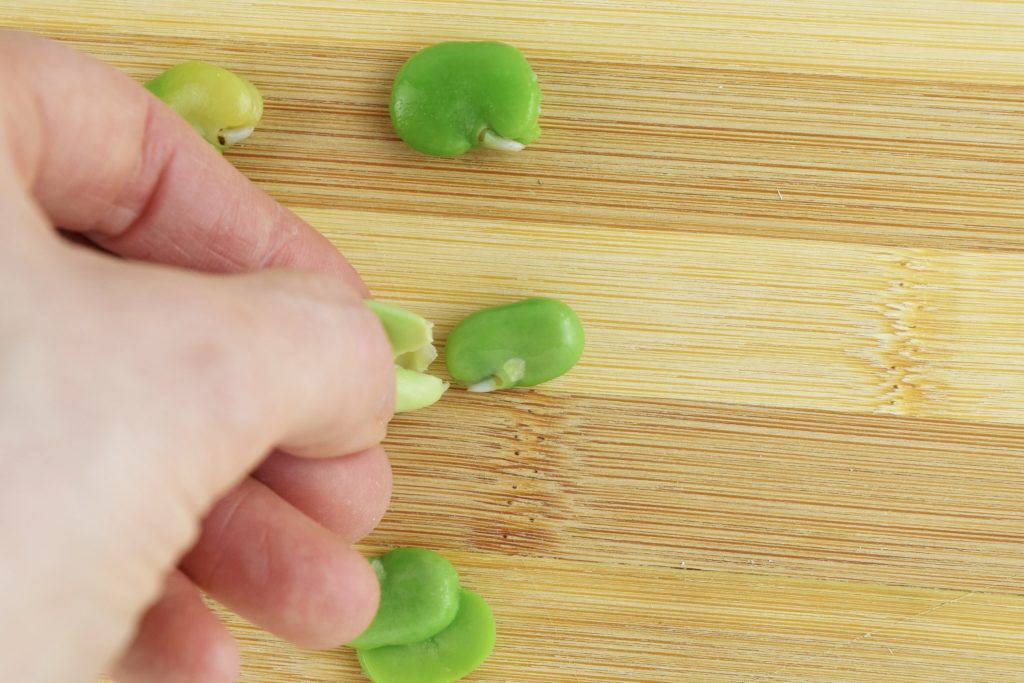
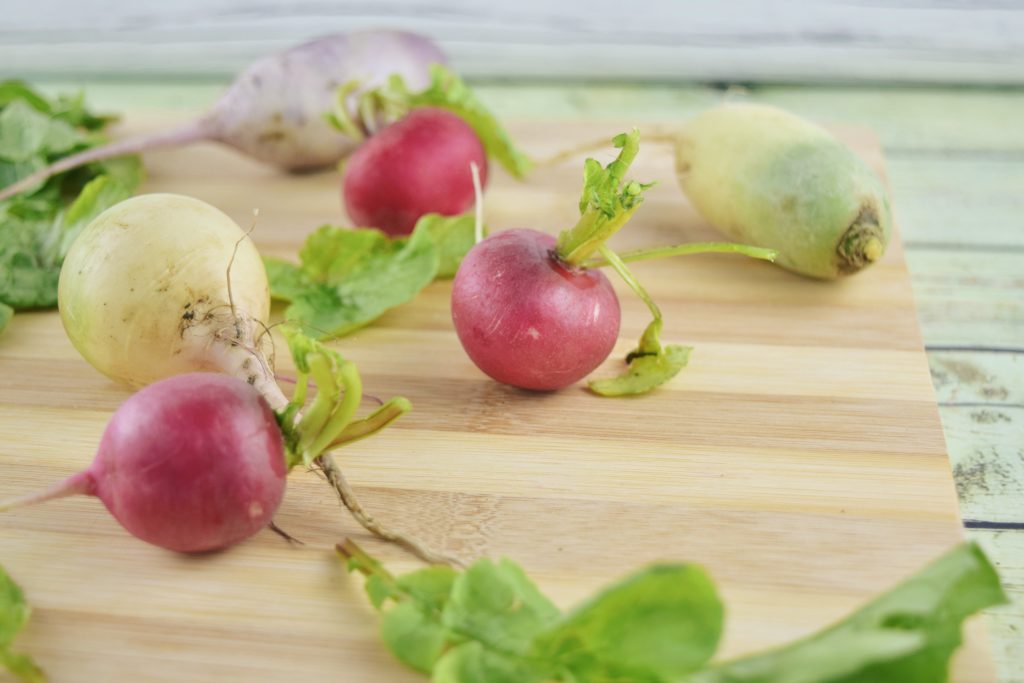
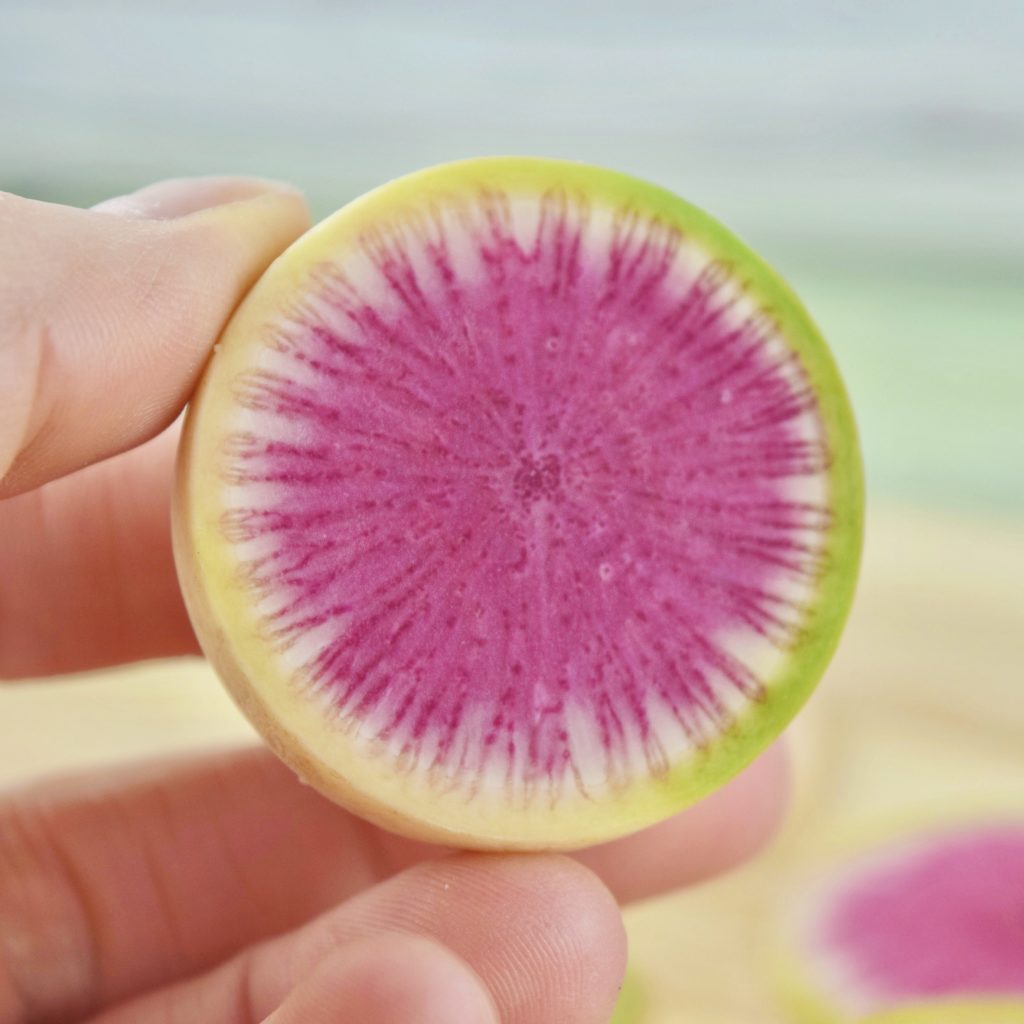
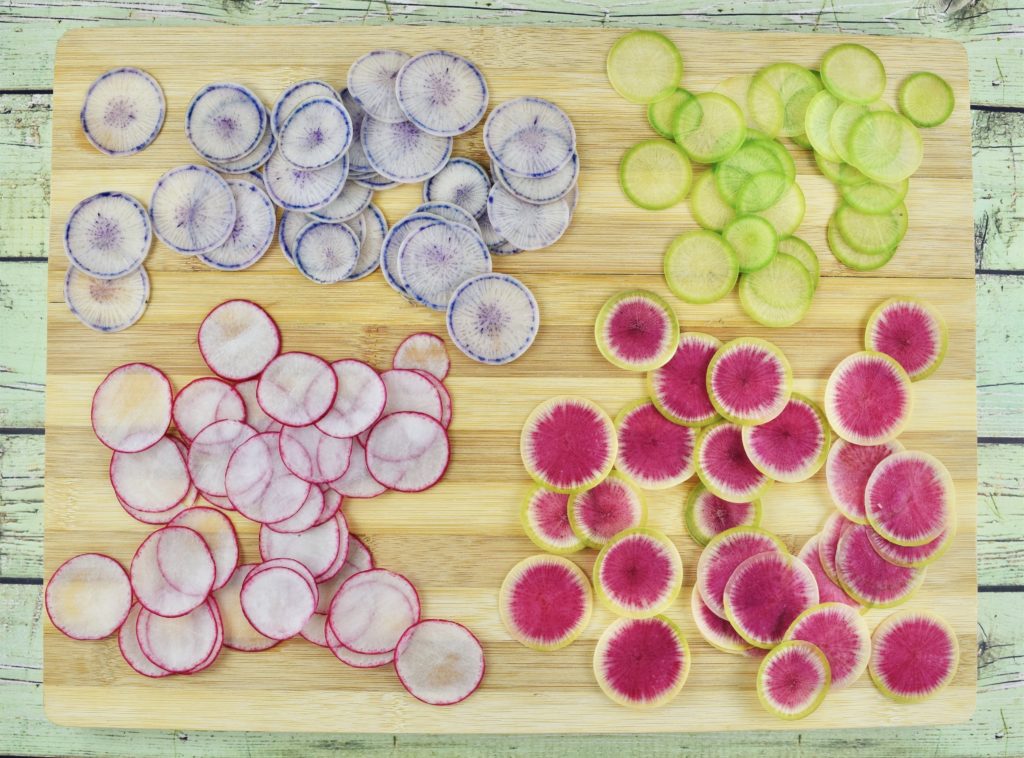
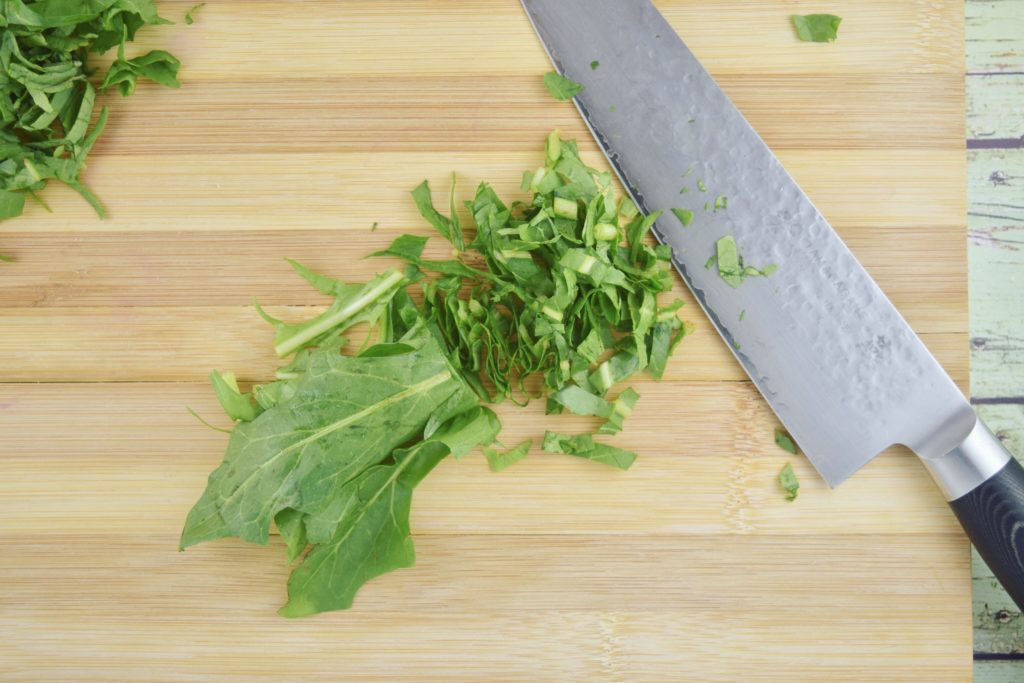
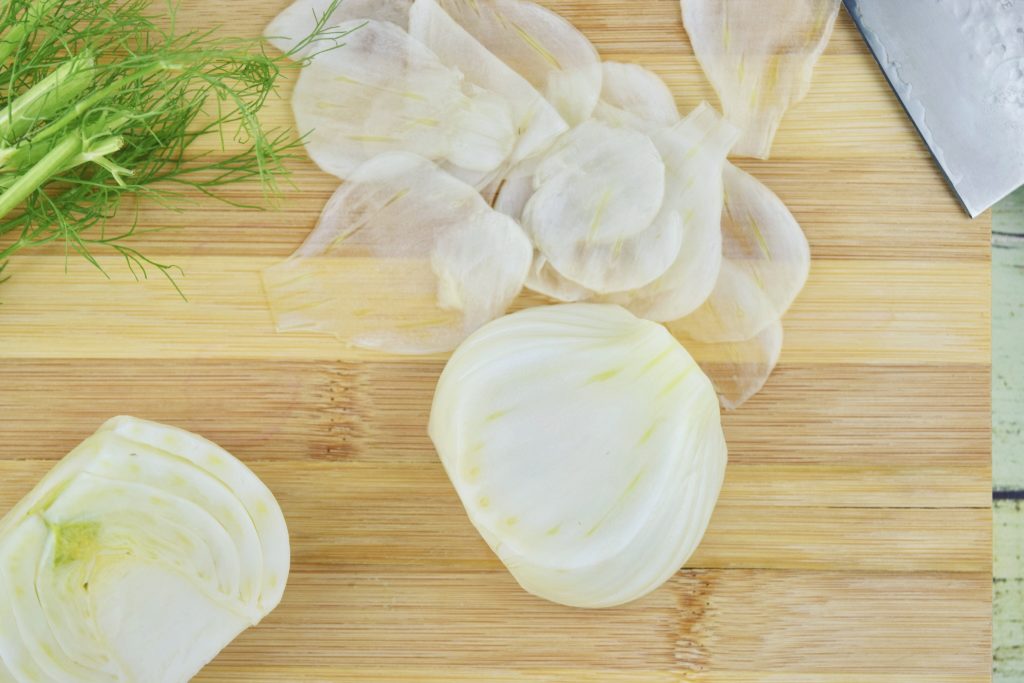
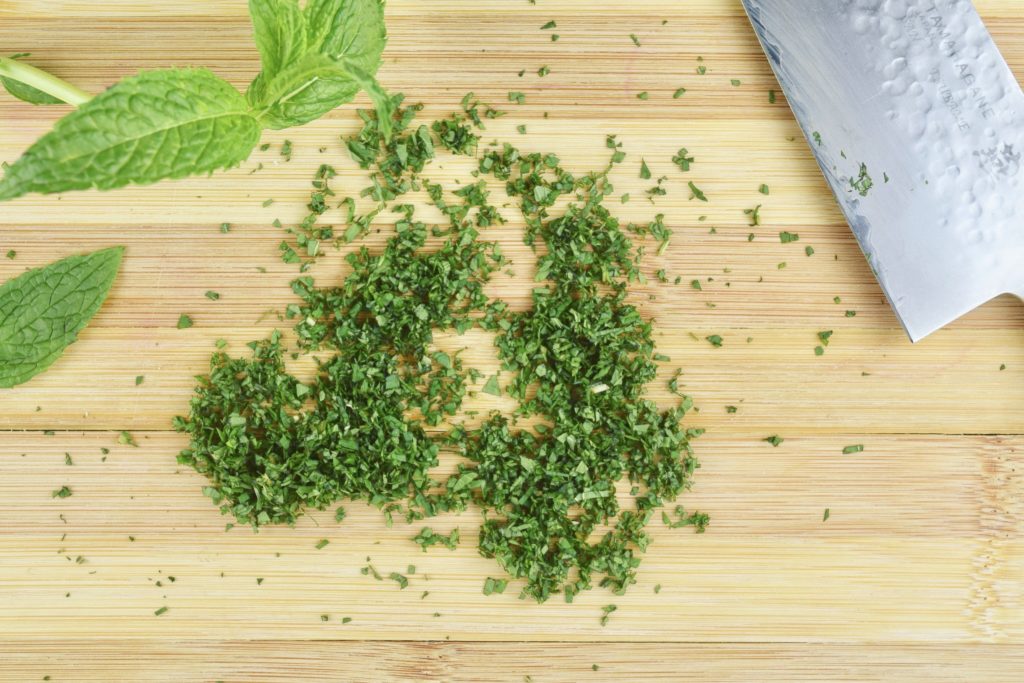
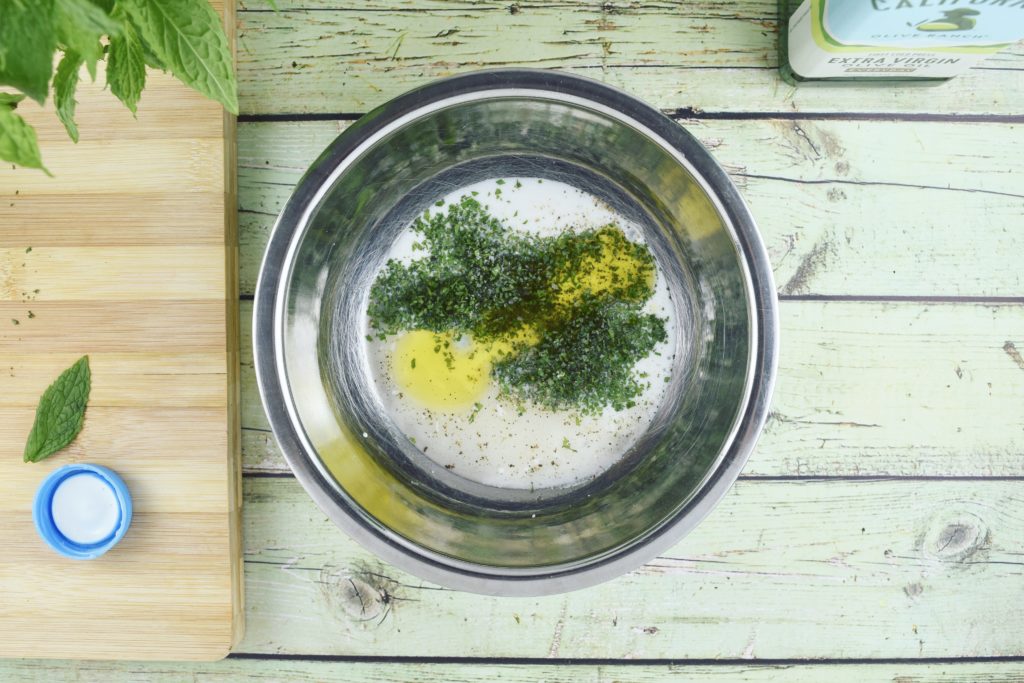
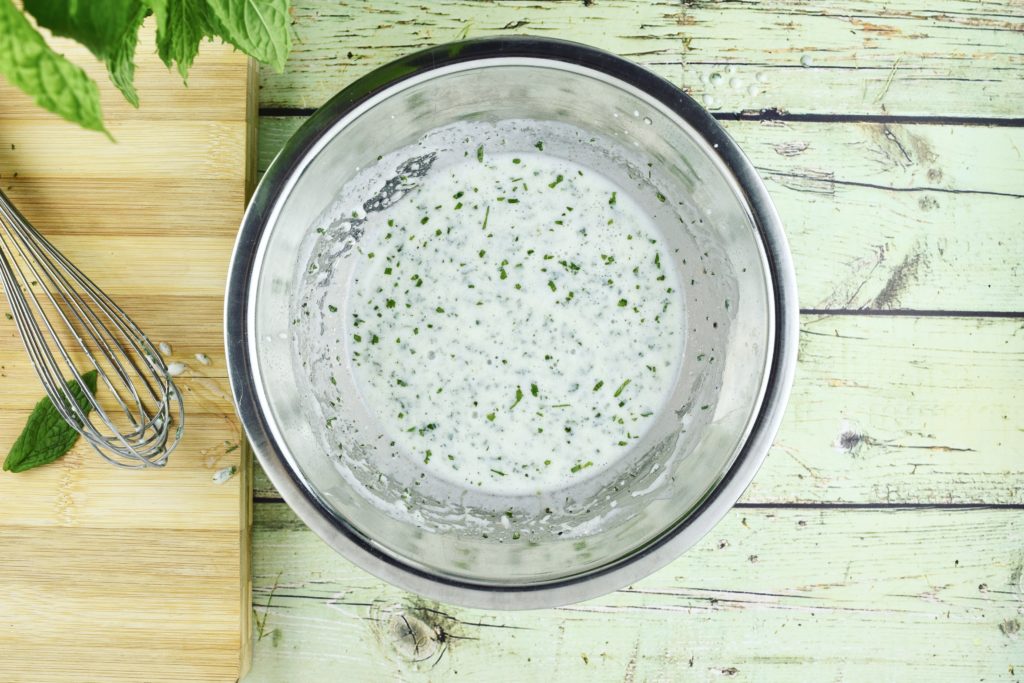
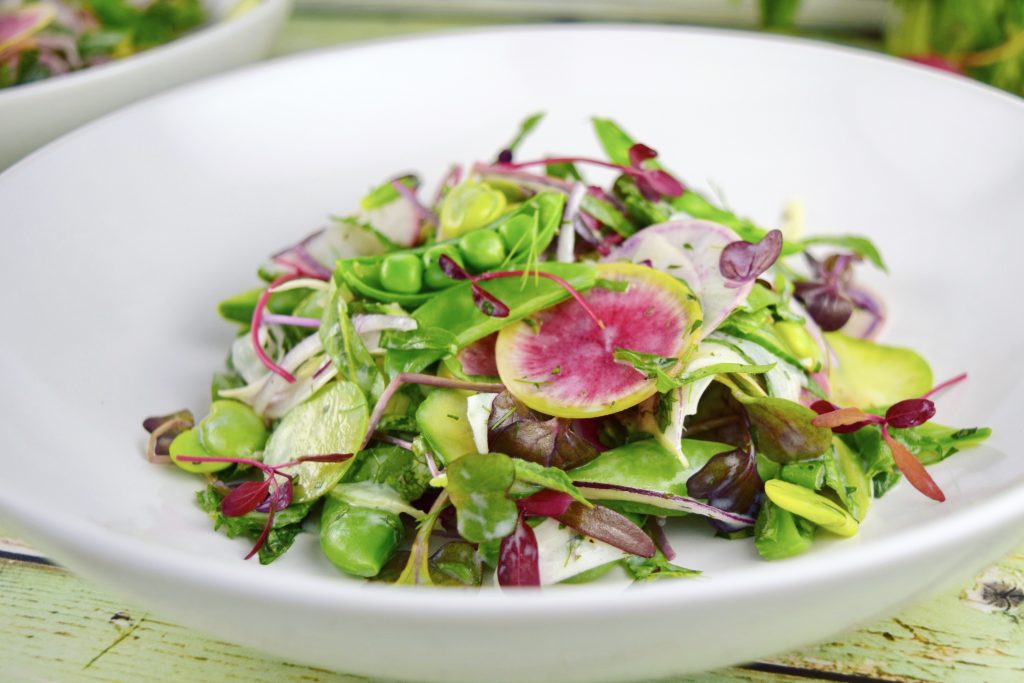
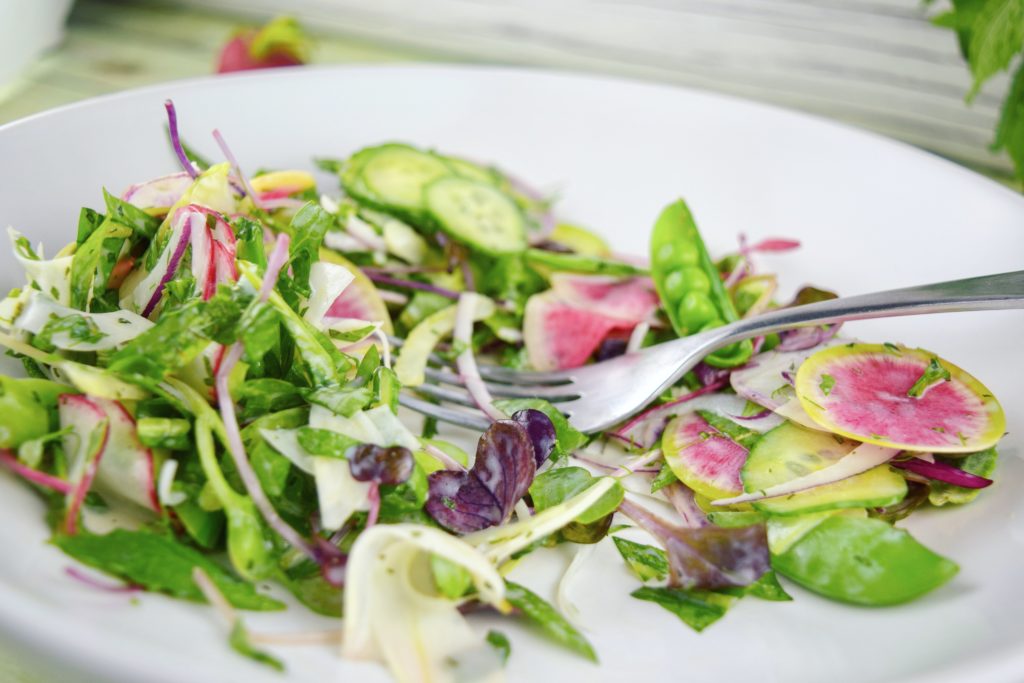
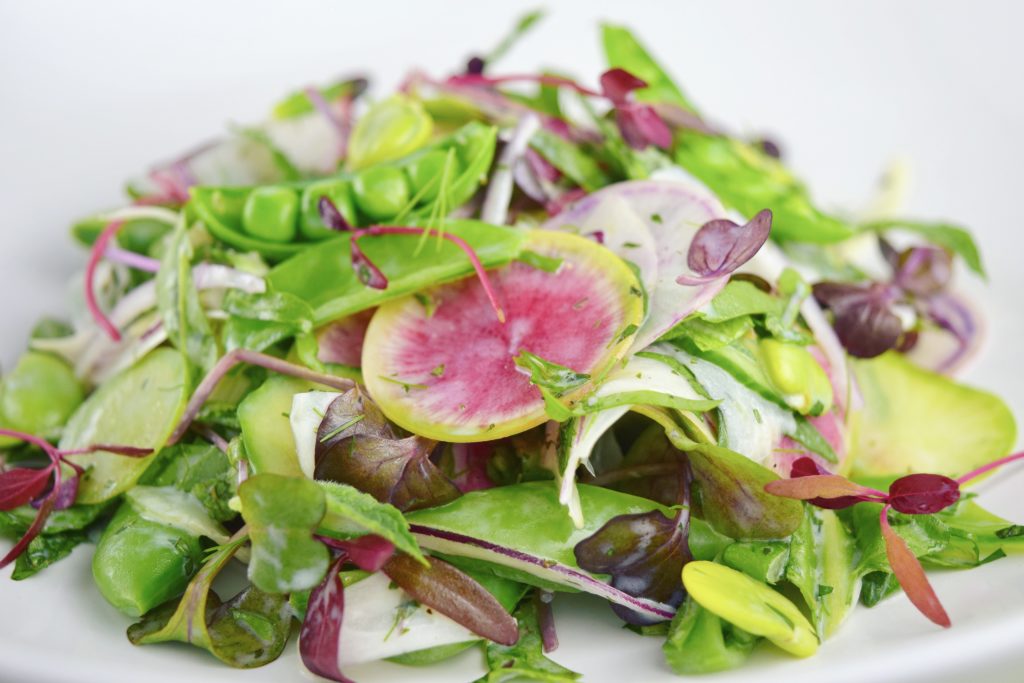
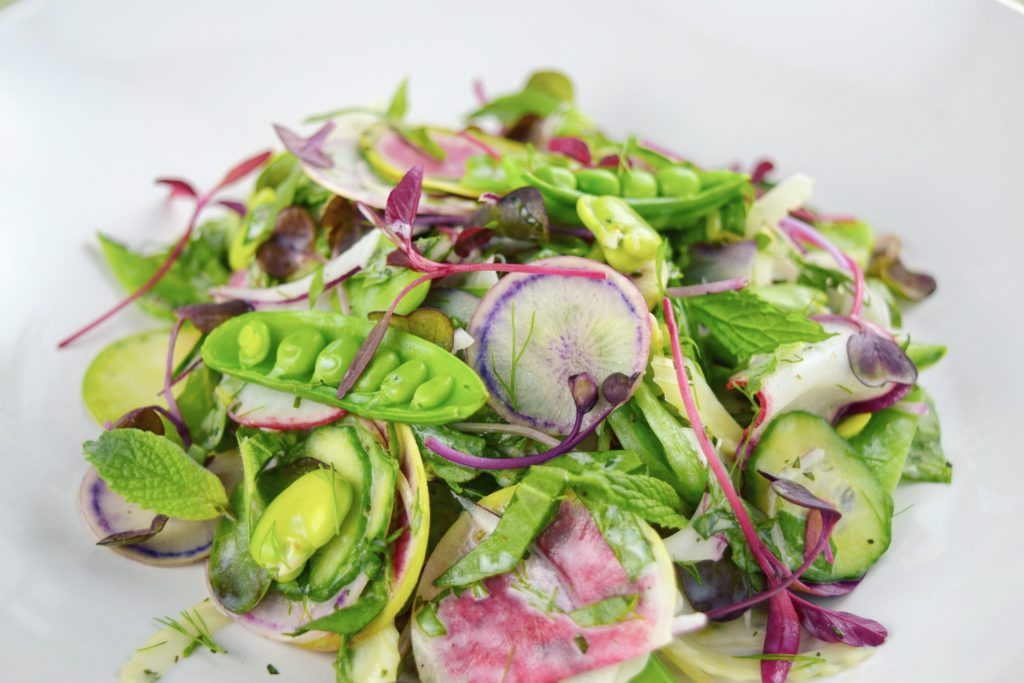


Leave a Reply